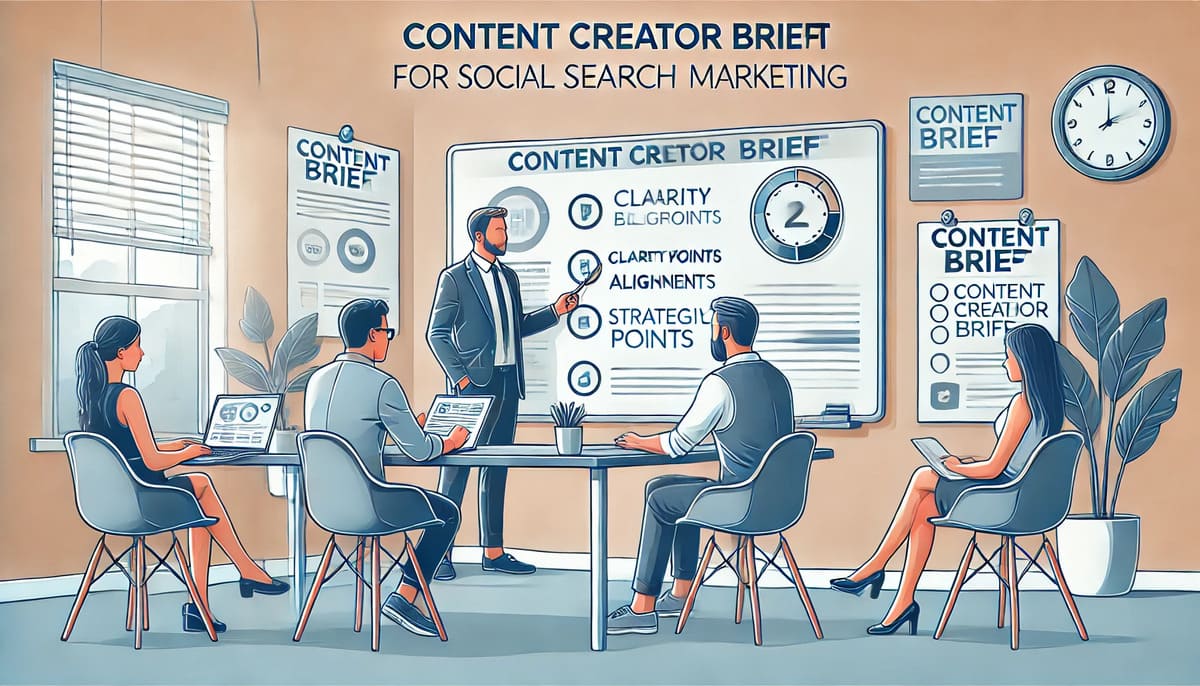Crafting Effective Content Creator Briefs: A Guide to Aligning Your Marketing Goals

Learn how to create clear and actionable content briefs that align your creators with your marketing objectives, ensuring consistency and effectiveness across platforms.
How to Create Effective Content Creator Briefs for Social Search Marketing
30-Second Summary: Crafting effective content briefs is essential for aligning your content creators with your marketing goals. This guide explores the key components of a content creator brief, from setting objectives to defining audience insights and including SEO best practices, ensuring your content achieves its maximum potential.
In today’s digital landscape, content creators play a vital role in bringing your brand’s message to life. However, without clear guidance, even the best creators can struggle to produce content that aligns with your marketing objectives. An effective content creator brief acts as a roadmap, providing the essential details needed to create high-quality content that resonates with your target audience. This guide breaks down the components of a successful content brief, making it easy to bridge the gap between your marketing strategy and your content creation.
1. Set Clear Objectives for Your Content
Every piece of content should have a purpose, whether it’s raising brand awareness, educating your audience, or driving sales. Clearly define the main objective of the content and outline its role in your overall marketing strategy. A well-defined objective helps content creators understand the direction and focus of the piece, allowing them to craft content that fulfills your specific goals.
Tips for Setting Objectives:
- Be Specific: Rather than a general goal like “increase engagement,” specify “drive 15% more traffic from social channels.”
- Identify the Desired Action: Explain what you want the audience to do after engaging with the content—sign up, purchase, share, etc.
2. Define Your Target Audience
An in-depth understanding of the target audience is essential for any content creator. Include insights about your audience’s demographics, psychographics, and preferences to guide the tone, style, and language of the content. Providing these details allows content creators to create more personalized and engaging pieces.
Audience Insights to Include:
- Age, Location, Interests: Helps tailor content to be relatable and appealing.
- Pain Points and Needs: Identifying audience challenges enables creators to address relevant issues.
- Stage in the Customer Journey: Content that resonates with someone new to your brand may differ from content for a returning customer.
3. Highlight Key Search Intent and SEO Requirements
Incorporating SEO elements into your brief is crucial to ensure the content ranks well and reaches the intended audience. Make sure to provide target keywords, related phrases, and any specific SEO requirements like meta descriptions or alt text guidelines.
SEO Components to Include:
- Primary and Secondary Keywords: Indicate the main keyword for the piece and any supporting terms.
- Search Intent: Define whether the content is intended for informational, navigational, or transactional searches.
- Linking Strategy: Include any internal links to other related pages, along with suggestions for external links to reputable sources.
4. Specify Content Format and Tone
The format and tone of content should align with both the brand’s voice and the platform it’s intended for. For example, a LinkedIn post might call for a professional tone, while Instagram content may allow for a more casual approach. By specifying these elements, you help content creators understand the desired structure and style.
Examples of Format and Tone Specifications:
- Content Type: Blog post, infographic, social media post, etc.
- Word Count: Indicate the preferred length to ensure completeness without overloading.
- Tone of Voice: Friendly, authoritative, casual, or formal—describe how you want the audience to feel.
5. Outline Key Messaging and Brand Guidelines
Consistency is crucial for brand recognition. Provide a clear outline of any key messages or brand guidelines that should be followed. This can include preferred terminology, taglines, or unique selling points that help differentiate your brand.
Examples of Brand Guidelines to Include:
- Messaging: Highlight core messages or themes that should be emphasized.
- Visual Guidelines: If applicable, include suggestions for image styles, color schemes, or fonts.
- Brand Voice and Personality: Describe your brand’s unique style, whether it’s fun, professional, or inspiring.
6. Define the Content Lifecycle and Repurposing Strategy
To maximize content reach, consider how the piece can be repurposed across different channels. Provide suggestions for how the content can be adapted, whether through snippets for social media, condensed versions for newsletters, or repurposed visuals for various platforms.
Repurposing Ideas:
- Social Media Snippets: Use key insights or quotes for quick posts.
- Infographic Creation: For content-heavy pieces, convert data into a visual format.
- Video Content: Consider turning blog posts into short-form videos for platforms like YouTube or Instagram Reels.
The Value of an Effective Content BriefCreating a content brief may take time, but it’s an investment that pays off by ensuring your content aligns with your goals and reaches the right audience. By providing clear objectives, defining the audience, including SEO guidelines, and maintaining brand consistency, you set your content creators up for success. A well-structured content brief bridges the gap between marketing strategy and effective content, helping you achieve your desired outcomes with every piece created.
Takeaway: A strong content brief is essential for content that hits the mark every time. By defining goals, understanding your audience, and providing a structured approach, you empower creators to deliver impactful, high-performing content that aligns with your brand’s mission.